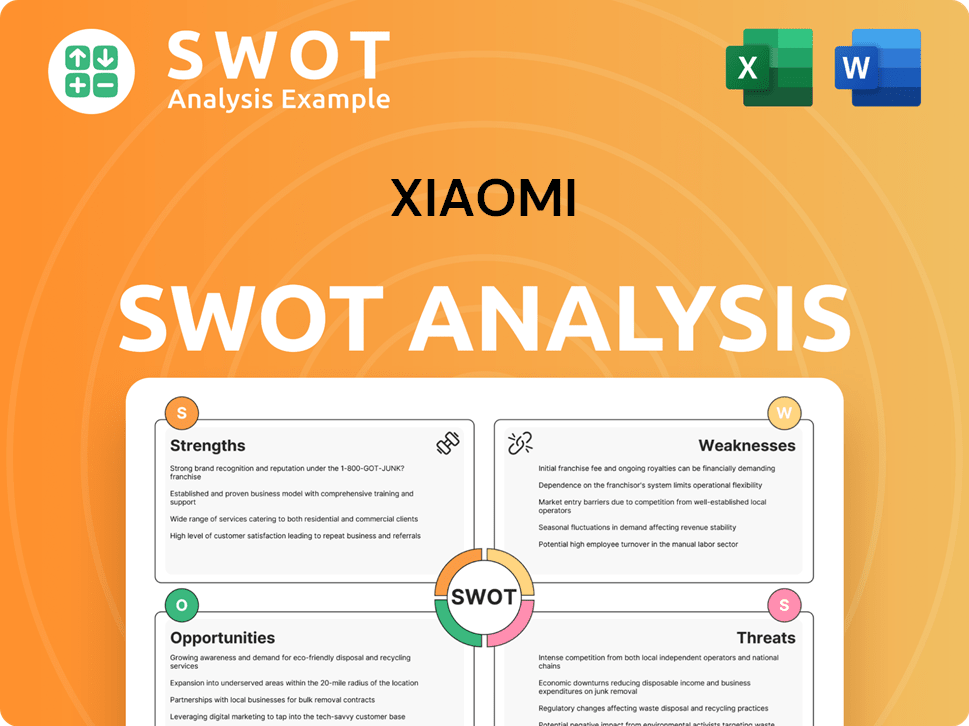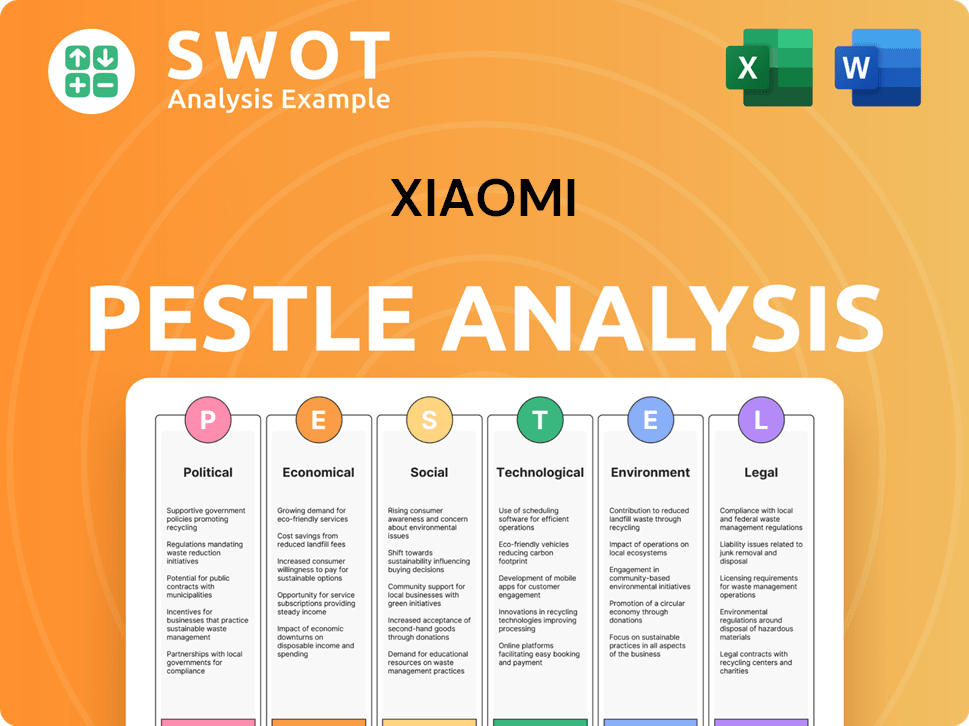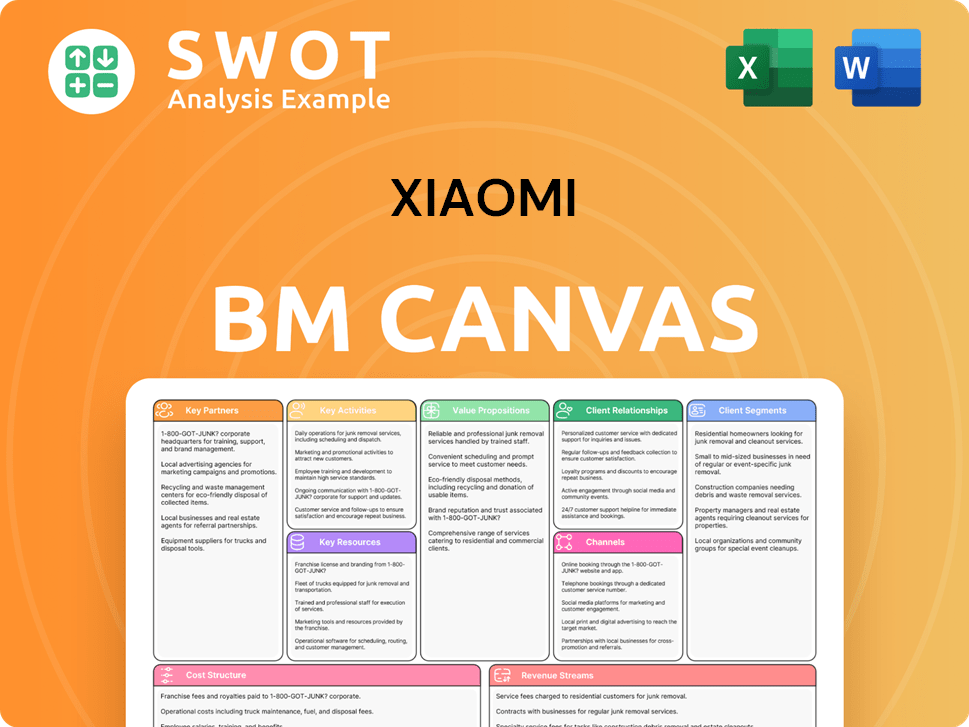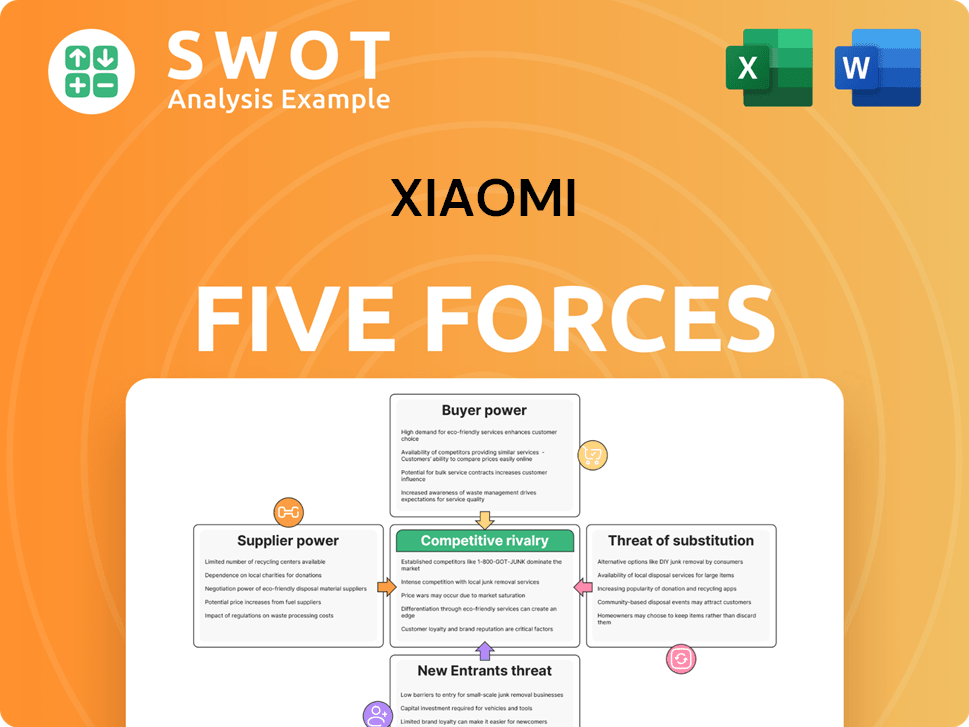Xiaomi Bundle
How Does Xiaomi Conquer the Tech Battlefield?
Xiaomi, a tech titan born in Beijing, has rapidly transformed from a startup into a global force. Its journey, marked by innovative hardware, software, and internet services, has disrupted the Xiaomi SWOT Analysis, particularly in emerging markets. But how does Xiaomi maintain its edge in the cutthroat world of consumer electronics?

This exploration of the Xiaomi competitive landscape delves into its evolution, business model, and ambitious expansion beyond smartphones. Understanding Xiaomi's strategies for market dominance, including its approach to the tech industry competition, is key to appreciating its impact. We'll dissect Xiaomi's market analysis, examining its primary competitors and the challenges it faces in the smartphone market and beyond.
Where Does Xiaomi’ Stand in the Current Market?
Xiaomi has established itself as a significant player in the global technology market, particularly within the smartphone sector. As of Q1 2024, Xiaomi held approximately 14% of the global smartphone market share, ranking third behind Samsung and Apple. Its core operations encompass smartphones, AIoT (Artificial Intelligence of Things) devices, and internet services, catering to a diverse customer base from budget-conscious consumers to tech enthusiasts.
The company's value proposition centers on offering innovative technology at competitive prices. This strategy has enabled Xiaomi to gain significant market share, especially in emerging markets. Xiaomi's focus on value and innovation has allowed it to compete effectively in the tech industry competition. Furthermore, the company's extensive geographic presence, including strongholds in Asia, Europe, and Latin America, supports its broad market reach.
Over time, Xiaomi has evolved its market positioning. Initially known for budget-friendly devices, it has expanded into the premium segment. This shift is evident in its flagship series, such as the Xiaomi 14, which aims to challenge established players like Samsung and Apple. Xiaomi's competitive advantages in 2024 include its diverse product portfolio and strong brand recognition in key markets. For a deeper understanding of Xiaomi's business model, consider reading about the Revenue Streams & Business Model of Xiaomi.
Xiaomi's global market share in Q1 2024 was approximately 14%, placing it third in the smartphone market. This position highlights its strong competitive standing against rivals like Apple and Samsung. Xiaomi's strategies for market dominance include continuous product innovation and expansion into new markets.
Xiaomi's product portfolio includes smartphones, AIoT devices, and internet services. The company has strategically moved into the premium segment with its flagship smartphone series. Analyzing Xiaomi's pricing strategy against competitors reveals a focus on offering value without compromising quality.
In 2023, Xiaomi reported total revenue of approximately RMB 271 billion (around $37.4 billion USD). The adjusted net profit increased by 126.3% year-on-year, demonstrating robust financial health. Xiaomi's financial performance and its competitive standing are supported by its diversified product portfolio and expanding global reach.
Xiaomi has a strong presence in Asia (especially India and China), Europe, and Latin America. Its position in some mature Western markets is still developing compared to its established rivals. Xiaomi's marketing strategies to gain market share include localized campaigns and partnerships.
Xiaomi's competitive landscape is shaped by its global market share, product innovation, and financial performance. The company faces challenges such as intense competition in the smartphone market and the need to maintain its competitive pricing strategy. The future of Xiaomi's competitive landscape depends on its ability to adapt to changing consumer preferences and technological advancements.
- Xiaomi's main rivals in China include Huawei and other local brands.
- Xiaomi's global market share compared to Apple highlights its strong position.
- How Xiaomi competes with Samsung in India showcases its regional strategies.
- The impact of the chip shortage on Xiaomi's competitive position has been significant.
Xiaomi SWOT Analysis
- Complete SWOT Breakdown
- Fully Customizable
- Editable in Excel & Word
- Professional Formatting
- Investor-Ready Format

Who Are the Main Competitors Challenging Xiaomi?
The Xiaomi competitive landscape is defined by intense rivalry across its diverse product categories. The company faces significant challenges from both direct and indirect competitors, impacting its market share and strategic positioning within the tech industry. A thorough Xiaomi market analysis reveals a complex interplay of factors influencing its performance.
The Xiaomi industry is characterized by rapid innovation and evolving consumer preferences, requiring the company to continuously adapt. Understanding Xiaomi's competitors is crucial for evaluating its strategies and future prospects. This analysis will explore the key players and competitive dynamics shaping the company's trajectory.
In the smartphone market, Xiaomi's main rivals include Samsung, Apple, Huawei, Oppo, Vivo, and Honor. Samsung, a global leader, competes across all price points, leveraging its brand recognition and extensive distribution. Apple focuses on the premium segment with its ecosystem lock-in and high-profit margins. Chinese manufacturers like Oppo, Vivo, and Honor differentiate through camera technology and localized marketing.
Samsung is a primary competitor, offering a wide range of smartphones across various price points. In 2024, Samsung held a significant global market share, consistently challenging Xiaomi's position in key markets.
Apple competes in the premium segment with its iPhone series, known for its ecosystem and brand loyalty. Apple's high-profit margins and strong brand recognition pose a significant challenge to Xiaomi, particularly in developed markets.
Huawei, another major player, competes directly with Xiaomi, especially in China and other Asian markets. Huawei's focus on innovation and R&D has allowed it to offer competitive products, though it faces challenges in some international markets.
Oppo and Vivo are strong competitors, particularly in the mid-range and budget segments. They differentiate through camera technology and marketing strategies, gaining significant market share in various regions.
Honor, formerly a sub-brand of Huawei, is now an independent entity, competing with Xiaomi in the mid-range and budget categories. Honor's focus on design and value has made it a strong contender.
Other Chinese manufacturers such as Realme and OnePlus also pose a threat, offering competitive pricing and features. These brands often target specific market segments, adding to the overall competitive pressure.
Beyond smartphones, Xiaomi's competitive landscape extends to the AIoT and smart home appliance markets. Here, the company faces competition from established brands and emerging startups. Haier and Midea are key rivals in smart appliances, while Google, Amazon, and Apple compete in the smart home ecosystem. These companies leverage their brand presence and product ranges to challenge Xiaomi. The smartphone market in India, for instance, showcases intense competition, with Xiaomi facing pressure from Samsung and other Chinese brands. Mergers, alliances, and new players focusing on niche markets further shape the competitive environment, compelling Xiaomi to innovate and adapt its strategies. To learn more about how Xiaomi approaches the market, consider reading about the Marketing Strategy of Xiaomi.
Several factors influence Xiaomi's competitive position, including pricing, product features, brand perception, and distribution. Xiaomi's strategies must address these factors to maintain and grow its market share.
- Pricing Strategy: Xiaomi's competitive pricing is a key differentiator, but it must balance this with profitability.
- Product Innovation: Continuous innovation in features and design is crucial to stay ahead of rivals.
- Brand Building: Enhancing brand perception and loyalty is essential for long-term success.
- Distribution and Retail: Expanding and optimizing distribution channels is vital for market reach.
Xiaomi PESTLE Analysis
- Covers All 6 PESTLE Categories
- No Research Needed – Save Hours of Work
- Built by Experts, Trusted by Consultants
- Instant Download, Ready to Use
- 100% Editable, Fully Customizable

What Gives Xiaomi a Competitive Edge Over Its Rivals?
The competitive advantages of Xiaomi are multifaceted, setting it apart in the dynamic tech industry. Xiaomi's 'triathlon' business model, which integrates hardware, internet services, and new retail, is a key differentiator. This approach allows the company to offer high-quality products at competitive prices, a strategy often associated with its 'honest pricing' approach. This model is a significant factor in the company's ability to compete effectively in the smartphone market and beyond.
Another substantial advantage is Xiaomi's extensive IoT platform. As of December 2023, the company's IoT platform boasted over 700 million connected devices (excluding smartphones, tablets, and laptops) and 14.5 million users with five or more connected devices. This vast ecosystem enhances customer loyalty and provides recurring revenue streams from internet services, further solidifying its market position. The company continuously leverages these advantages in its marketing campaigns, product development, and strategic partnerships to maintain its competitive edge.
Brand equity and customer loyalty, fostered through its active user community and emphasis on user feedback, further enhance its position. Xiaomi's agile product development and rapid iteration cycles, often driven by user engagement, allow it to quickly adapt to market demands. Its strong supply chain management, particularly in manufacturing and distribution, contributes to cost efficiencies and wider availability of its products. For more insights, consider reading about Owners & Shareholders of Xiaomi.
Xiaomi's 'triathlon' model integrates hardware, internet services, and new retail. This structure allows for competitive pricing and a diversified revenue stream. This approach helps the company to maintain a strong position in the Xiaomi competitive landscape.
The vast IoT platform, with over 700 million connected devices, provides a significant advantage. This ecosystem fosters customer loyalty and generates recurring revenue. Xiaomi's expansion into the IoT market is a key strategy for market dominance.
Xiaomi's strong focus on user feedback and active community engagement builds brand loyalty. Agile product development and rapid iteration cycles allow for quick market adaptation. This approach is crucial in the tech industry competition.
Efficient supply chain management contributes to cost efficiencies and product availability. This strength helps Xiaomi compete effectively in the smartphone market. Strong supply chain management is essential for Xiaomi's strategies for market dominance.
Xiaomi's competitive advantages include its unique business model, extensive IoT ecosystem, and strong customer engagement. These factors enable the company to compete effectively in the global market. Analyzing Xiaomi's pricing strategy against competitors reveals its commitment to value.
- 'Triathlon' business model for competitive pricing.
- Vast IoT platform with over 700 million connected devices.
- Strong brand equity and customer loyalty.
- Agile product development and rapid iteration.
- Efficient supply chain management.
Xiaomi Business Model Canvas
- Complete 9-Block Business Model Canvas
- Effortlessly Communicate Your Business Strategy
- Investor-Ready BMC Format
- 100% Editable and Customizable
- Clear and Structured Layout

What Industry Trends Are Reshaping Xiaomi’s Competitive Landscape?
The Brief History of Xiaomi reveals its journey within a dynamic competitive landscape. The company faces intense competition in the tech industry, especially within the smartphone market. Evaluating Xiaomi's market analysis requires understanding the interplay of industry trends, future challenges, and strategic opportunities.
The competitive landscape for Xiaomi is shaped by technological advancements, regulatory changes, and evolving consumer preferences. These factors influence Xiaomi's market positioning and strategic decisions. The company's ability to navigate these elements will determine its future success in the tech industry and its ability to compete effectively with its rivals.
Technological advancements in AI, 5G, and IoT are key drivers of innovation. Regulatory changes, particularly concerning data privacy, influence market entry and operations. Consumer preferences are shifting towards integrated, sustainable, and personalized tech experiences.
Data security and interoperability pose challenges due to AI and IoT's increasing sophistication. Geopolitical tensions and economic shifts, such as inflation, threaten operational stability. Intense competition in emerging markets puts pressure on pricing and innovation.
Expansion into new geographic markets, especially regions with growing middle classes, is a key opportunity. Diversifying the product portfolio, like entering the EV market, provides growth avenues. Strategic partnerships and collaborations are essential for navigating complexities.
Xiaomi is likely to evolve towards an integrated hardware and software model. There will be a strong emphasis on AI-driven services. The company will continue its focus on accessible innovation to remain resilient in a rapidly changing environment.
Xiaomi's competitive advantages in 2024 include its strong brand perception and value-for-money products. The company's marketing strategies focus on gaining market share through aggressive pricing and innovative features. Xiaomi's research and development spending is a critical factor in maintaining its competitive position, with investments aimed at driving innovation in areas like AI and IoT.
- Xiaomi's global market share in Q1 2024 was around 14%, ranking third globally.
- The smartphone market remains highly competitive, with Samsung and Apple as key rivals.
- Xiaomi's expansion into the IoT market faces competition from established players like Samsung and Apple.
- The company’s financial performance, including revenue and profit margins, is crucial for its competitive standing.
Xiaomi Porter's Five Forces Analysis
- Covers All 5 Competitive Forces in Detail
- Structured for Consultants, Students, and Founders
- 100% Editable in Microsoft Word & Excel
- Instant Digital Download – Use Immediately
- Compatible with Mac & PC – Fully Unlocked

Related Blogs
- What are Mission Vision & Core Values of Xiaomi Company?
- What is Growth Strategy and Future Prospects of Xiaomi Company?
- How Does Xiaomi Company Work?
- What is Sales and Marketing Strategy of Xiaomi Company?
- What is Brief History of Xiaomi Company?
- Who Owns Xiaomi Company?
- What is Customer Demographics and Target Market of Xiaomi Company?
Disclaimer
All information, articles, and product details provided on this website are for general informational and educational purposes only. We do not claim any ownership over, nor do we intend to infringe upon, any trademarks, copyrights, logos, brand names, or other intellectual property mentioned or depicted on this site. Such intellectual property remains the property of its respective owners, and any references here are made solely for identification or informational purposes, without implying any affiliation, endorsement, or partnership.
We make no representations or warranties, express or implied, regarding the accuracy, completeness, or suitability of any content or products presented. Nothing on this website should be construed as legal, tax, investment, financial, medical, or other professional advice. In addition, no part of this site—including articles or product references—constitutes a solicitation, recommendation, endorsement, advertisement, or offer to buy or sell any securities, franchises, or other financial instruments, particularly in jurisdictions where such activity would be unlawful.
All content is of a general nature and may not address the specific circumstances of any individual or entity. It is not a substitute for professional advice or services. Any actions you take based on the information provided here are strictly at your own risk. You accept full responsibility for any decisions or outcomes arising from your use of this website and agree to release us from any liability in connection with your use of, or reliance upon, the content or products found herein.